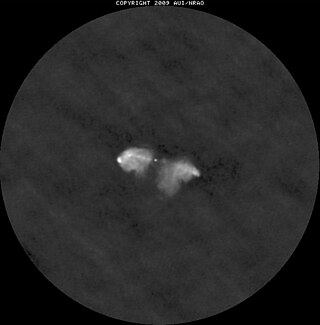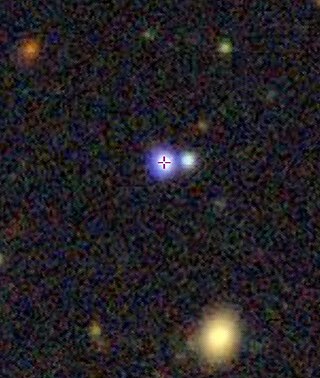Related Research Articles

In the fields of Big Bang theory and cosmology, reionization is the process that caused electrically neutral atoms in the universe to reionize after the lapse of the "dark ages".
In astronomy, the intracluster medium (ICM) is the superheated plasma that permeates a galaxy cluster. The gas consists mainly of ionized hydrogen and helium and accounts for most of the baryonic material in galaxy clusters. The ICM is heated to temperatures on the order of 10 to 100 megakelvins, emitting strong X-ray radiation.

3C 449 is a low-redshift Fanaroff and Riley class I radio galaxy. It is thought to contain a highly warped circumnuclear disk surrounding the central active galactic nucleus (AGN). The name signifies that it was the 449th object of the Third Cambridge Catalog of Radio Sources (3C), published in 1959.

3C 249.1 is a Seyfert galaxy located in the constellation Draco. It hosts a powerful radio source and is located at redshift 0.3115, with a peculiar radio structure. One of its radio lobes is classified as having a Fanaroff-Riley classification Type II, while the other lobe has no features nor containing hotspots.

3C 285 is a radio galaxy located in the constellation Canes Venatici. It is located about 1 bilion light years away. It is a Fanaroff-Riley 2 radio galaxy and is hosted in a disturbed spiral galaxy.
TXS 0506+056 is a very high energy blazar – a quasar with a relativistic jet pointing directly towards Earth – of BL Lac-type. With a redshift of 0.3365 ± 0.0010, it has a luminosity distance of about 1.75 gigaparsecs. Its approximate location on the sky is off the left shoulder of the constellation Orion. Discovered as a radio source in 1983, the blazar has since been observed across the entire electromagnetic spectrum.

NGC 708 is an elliptical galaxy located 240 million light-years away in the constellation Andromeda and was discovered by astronomer William Herschel on September 21, 1786. It is classified as a cD galaxy and is the brightest member of Abell 262. NGC 708 is a weak FR I radio galaxy and is also classified as a type 2 Seyfert galaxy.

III Zw 2 is a Seyfert 1 galaxy located in the Pisces constellation. It has a redshift of 0.089 and is notable as the first of its kind to exhibit a superluminal jet.

An extended emission-line region (EELR) is a giant interstellar cloud ionized by the radiation of an active galactic nucleus (AGN) inside a galaxy or photons produced by the shocks associated with the radio jets. An EELR can appear as a resolved cloud in relative nearby galaxies and as narrow emission lines in more distant galaxies.
4C +48.48 is a radio galaxy located in the constellation Cygnus. At the redshift of 2.343, it is one of the most distant galaxies ever seen, since light has taken at least 11 billion light-years to reach Earth.

IRAS 09104+4109 is a galaxy located in the constellation Lynx. With a redshift of 0.440797, the light travel time for this galaxy, corresponds to 4.8 billion light-years from Earth. It is the brightest cluster galaxy in CDGS 25, also known as WHL J091345.5+405628 and a notable, unique ultraluminous infrared galaxy.

4C +09.17 is a quasar located in the constellation Orion. With a redshift of 2.108300, the object is located 10.6 billion light years from Earth and presents an extragalactic astrophysical jet morphology.

UM 287 known as PHL 868 and LBQS 0049+0045, is a quasar located in the Cetus constellation. Its redshift is 2.267134 estimating the object to be located 10.9 billion light-years away from Earth.

MRC 0406-244 also known as TN J0408-2418, is a radio galaxy producing an astrophysical jet, located in the constellation of Eridanus. At its redshift of 2.44, it is roughly ten billion light years from Earth.

MRC 0316-257 is a radio galaxy located in the constellation Fornax. Its redshift is 3.13, making the object located roughly 11 billion light-years from Earth.
PKS 0529-549 known as MRC 0529-549 and PKS B0529-549, is a radio galaxy located in the constellation Pictor. At the redshift of 2.57, the object is located nearly 10.8 billion light-years away from Earth.

4C +41.17 is a radio galaxy located in the constellation Auriga. With the redshift of 3.79, it is located nearly 11.7 billion light-years from Earth. At the time of its discovery in 1988, it was one of the most distant galaxies ever seen.

PKS 1402-012, also known as UM 632, is a quasar located in the constellation of Virgo. With a redshift of 2.51, the object is located 10.7 billion light-years from Earth.

4C +03.10 also known as PKS 0505+03 and OG +008, is a quasar located in the constellation of Orion. At a redshift of 2.46, the object is located 10.6 billion light-years away from Earth.

PG 1543+489, also known as QSO B1544+4855 and PGC 2325245, is a quasar located in the constellation of Boötes. At the redshift of 0.399, the object is located 4.5 billion light-years away from Earth. It was first discovered in 1983, by researchers who presented 114 objects in the Palomar-Green bright quasar survey, as one of the best studied samples of active galactic nuclei (AGN).
References
- ↑ "NED Search results for WISEA J154817.51-233701.8". NASA/IPAC Extragalactic Database.
- ↑ "Distant Radio Galaxies and their Environments - G.K. Miley & C. De Breuck". ned.ipac.caltech.edu. Retrieved 2024-05-30.
- ↑ Fanaroff, B. L.; Riley, J. M. (1974-05-01). "The morphology of extragalactic radio sources of high and low luminosity". Monthly Notices of the Royal Astronomical Society. 167 (1): 31P–36P. Bibcode:1974MNRAS.167P..31F. doi: 10.1093/mnras/167.1.31P . ISSN 0035-8711.
- ↑ Laing, R. (1989-01-01). "Radio Observation of Hot Spots". In Klaus Meisenheimer; Hermann-Josef Röser (eds.). Hot Spots in Extragalactic Radio Sources. Workshop Held at Ringberg Castle, Tegernsee, FRG, February 8–12, 1988. Lecture Notes in Physics. Vol. 327. Springer. pp. 27–44. Bibcode:1989LNP...327...27L. doi:10.1007/BFb0036010. ISBN 3-540-50993-3.
- ↑ Lonsdale, C. J.; Barthel, P. D. (1986-07-01). "Double hotspots and flow redirection in the lobes of powerful extragalactic radio sources". The Astronomical Journal. 92: 12–22. Bibcode:1986AJ.....92...12L. doi:10.1086/114130. ISSN 0004-6256.
- ↑ Cox, C. I.; Gull, S. F.; Scheuer, P. A. G. (1991-10-01). "Three-dimensional simulations of the jets of extragalactic radio sources". Monthly Notices of the Royal Astronomical Society. 252 (4): 558–585. Bibcode:1991MNRAS.252..558C. doi: 10.1093/mnras/252.4.558 . ISSN 0035-8711.
- ↑ Dunlop, J. S.; Peacock, J. A. (1990-11-01). "The redshift cut-off in the luminosity function of radio galaxies and quasars". Monthly Notices of the Royal Astronomical Society. 247: 19. Bibcode:1990MNRAS.247...19D. ISSN 0035-8711.
- ↑ CARILLI, C. L.; RÖTTGERING, H. J. A.; VAN OJIK, R.; MILEY, G. K.; VAN BREUGEL, W. J. M. (1997). "Radio Continuum Imaging of High-redshift Radio Galaxies". The Astrophysical Journal Supplement Series. 109 (1): 1–44. arXiv: astro-ph/9610157 . Bibcode:1997ApJS..109....1C. doi:10.1086/312973.
- ↑ Roettgering, H. J. A.; Miley, G. K.; Chambers, K. C.; MacChetto, F. (1995). "1995A&AS..114...51R Page 51". Astronomy and Astrophysics Supplement Series. 114: 51. Bibcode:1995A&AS..114...51R . Retrieved 2024-05-30.
- 1 2 Roettgering, H. J. A.; Van Ojik, R.; Miley, G. K.; Chambers, K. C.; Van Breugel, W. J. M.; De Koff, S. (1997). "1997A&A...326..505R Page 505". Astronomy and Astrophysics. 326: 505. arXiv: astro-ph/9608063 . Bibcode:1997A&A...326..505R . Retrieved 2024-05-30.
- 1 2 3 4 Terao, Koki; Nagao, Tohru; Onishi, Kyoko; Matsuoka, Kenta; Akiyama, Masayuki; Matsuoka, Yoshiki; Yamashita, Takuji (2022). "Multiline Assessment of Narrow-line Regions in z ~ 3 Radio Galaxies". The Astrophysical Journal. 929 (1): 51. arXiv: 2203.03390 . Bibcode:2022ApJ...929...51T. doi: 10.3847/1538-4357/ac5b71 .
- ↑ Matsuoka, K.; Nagao, T.; Maiolino, R.; Marconi, A.; Taniguchi, Y. (2009-09-01). "Chemical evolution of high-redshift radio galaxies". Astronomy and Astrophysics. 503 (3): 721–730. arXiv: 0905.1581 . Bibcode:2009A&A...503..721M. doi:10.1051/0004-6361/200811478. ISSN 0004-6361.
- ↑ Appenzeller, I.; Fricke, K.; Fürtig, W.; Gässler, W.; Häfner, R.; Harke, R.; Hess, H. -J.; Hummel, W.; Jürgens, P.; Kudritzki, R. -P.; Mantel, K. -H.; Meisl, W.; Muschielok, B.; Nicklas, H.; Rupprecht, G. (1998-12-01). "Successful commissioning of FORS1 - the first optical instrument on the VLT". The Messenger. 94: 1–6. Bibcode:1998Msngr..94....1A. ISSN 0722-6691.
- ↑ Seymour, Nick; Stern, Daniel; De Breuck, Carlos; Vernet, Joel; Rettura, Alessandro; Dickinson, Mark; Dey, Arjun; Eisenhardt, Peter; Fosbury, Robert; Lacy, Mark; McCarthy, Pat; Miley, George; Rocca-Volmerange, Brigitte; Röttgering, Huub; Stanford, S. Adam (2007-08-01). "The Massive Hosts of Radio Galaxies across Cosmic Time". The Astrophysical Journal Supplement Series. 171 (2): 353–375. arXiv: astro-ph/0703224 . Bibcode:2007ApJS..171..353S. doi:10.1086/517887. ISSN 0067-0049.
- ↑ De Breuck, Carlos; Seymour, Nick; Stern, Daniel; Willner, S. P.; Eisenhardt, P. R. M.; Fazio, G. G.; Galametz, Audrey; Lacy, Mark; Rettura, Alessandro; Rocca-Volmerange, Brigitte; Vernet, Joël (2010-12-01). "The Spitzer High-redshift Radio Galaxy Survey". The Astrophysical Journal. 725 (1): 36–62. arXiv: 1010.1385 . Bibcode:2010ApJ...725...36D. doi:10.1088/0004-637X/725/1/36. ISSN 0004-637X.
- ↑ Nagao, T.; Maiolino, R.; Marconi, A. (2006-03-01). "Gas metallicity in the narrow-line regions of high-redshift active galactic nuclei". Astronomy and Astrophysics. 447 (3): 863–876. arXiv: astro-ph/0508652 . Bibcode:2006A&A...447..863N. doi:10.1051/0004-6361:20054127. ISSN 0004-6361.